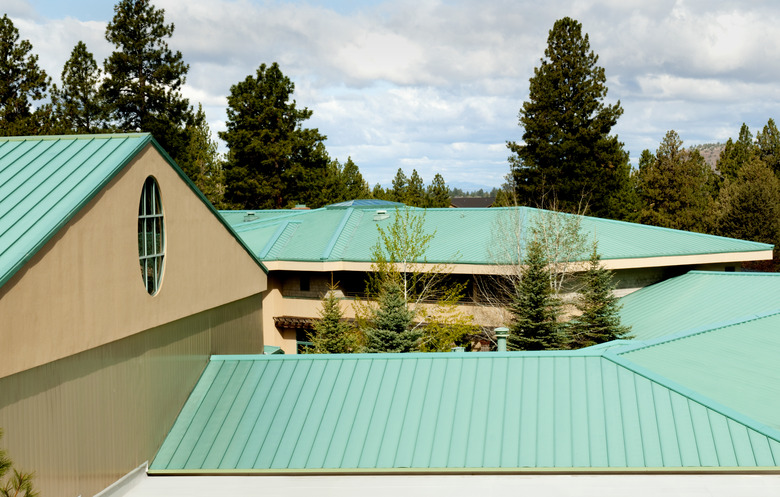How To Overlap Metal Roofing
Metal roofs are lightweight, easy to install and much more fire resistant than asphalt shingles. The installation of metal roofing involves placing large metal panels on the roof. The panels overlap, allowing water to flow from one panel to the next without being able to penetrate the area under the roofing panel. As a first line of defense against water damage, it is important that the metal roof overlap be implemented correctly.
Early Safety Precautions
Early Safety Precautions
Dress with safety in mind. Whether you're working with tin roofing sheets, performing corrugated roof sheeting installation, or handling a different metal material, working with metal means an increased probability of being cut, especially when working with power tools. Wear thick gloves when working with the metal roofing sheets, and keep safety goggles on at all times. Also keep a pair of ear plugs handy for when you are using saws or other power tools.
Installation Project Planning
Installation Project Planning
Measure and cut the metal sheet panels as necessary before installing them on the roof. The majority of the metal sheets will go onto the roof whole and intact. As you near the edges of the roof or any points where the roof has gables, you may need to cut the sheets to custom fit the space. Alternatively, you can use a ridge cap at the peak of the roof and at edge points, to ensure that water flows properly and doesn't fall through any gaps at the top of the roof. Use a tape measure to measure the sheet and lightly mark the cut with a felt-tip pen. When trimming the sheets, use tin snips to make small cuts, or tackle large cuts with electric shears or nibblers.
Metal Siding Installation
Metal Siding Installation
Identify your starting point. Start working in the bottom corner of the roof. If the wind and rain are known to come predominantly from one direction, then start at the end that is opposite of that direction. For example, if winds in the area blow primarily from the north, then start installing the roof at the southern end of the roof. If the prevailing direction of the weather is not known, start at the lowest corner of the building. While you do this, determine which direction the metal panels should be aligned. Each panel has an overlap ridge at one end and an underlap ridge at the other end. When the panel is laying flat on a surface, the side that touches flat is the underlap side. The opposite end, the overlap side, will be elevated slightly above the surface. When laying the metal panels on the roof, the overlap ridge of the new panel should straddle the underlap ridge of the panel before it.
Metal Sealing and Fastening
Metal Sealing and Fastening
Apply side lap sealant if the pitch of your roof is 2:12 or less. In other words, if the height of the roof drops by 2 inches for every 12 inches in length, you will need to use sealant to strengthen the overlap barrier. If lap sealant is used, simply apply a bead of sealant on top of the underlap ridge, going all the way down the length of the ridge, before the overlap ridge of the next panel is placed on top. The sealant will act as an adhesive to bond the two pieces together, as well as acting as a water barrier. Once sealed, screw fasteners into the metal sheet panels. The fasteners are screws that are 1 inch to 1.5 inches in length, with a rubber or neoprene washer at the head of the screw. The washer acts as a barrier to prevent water from penetrating the roof through the screw hole. Use an electric drill equipped with a screwdriver tip to install the fasteners. Place one screw on each side of the overlap/underlap ridge, then a third screw directly through the top of the ridge itself. Continue this screw pattern all the way down the overlap joint of the two panels, placing screws approximately every 6 inches down the length of the overlap joint.
